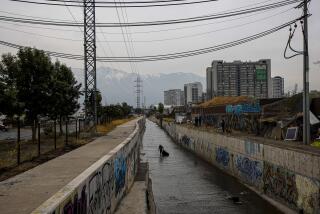Water Ruins Homes, Crops, Lives : Andes Flooded With Tragedy
- Share via
PUNO, Peru — The land where Anton Marcos Ticon raised livestock and grew potatoes, barley and other grains is no longer to be seen.
“It’s all under water,” he said.
He pointed toward the place where his home was flushed away by torrential rains and floods that began in January and still rage in an abnormally heavy rainy season around Lake Titicaca, which at 12,000 feet up in the Andes is the world’s highest lake.
“We lived there back to my great-grandfather’s generation. Now you can’t see anything.”
Ticon, 26, lives now with his family in a shack he built from sheet metal he was able to salvage from the roof of his old home. He said his 1-year-old son, like many other children, has respiratory problems because of the cold, wet weather.
The government in Lima, Peru’s capital 610 miles away, has reported no deaths due to the flooding that has raised the lake nearly nine feet above normal.
But the Red Cross in Puno said there have been deaths and that one of them was Agustin Huamani, his body lying in a wooden coffin one recent day as Aymara Indian men in black wool ponchos, black scarfs and felt hats stood around it.
Huamani, a 50-year-old father of eight, had died the night before of a heart attack after falling into the icy lake while cutting totora grass roots to feed his family.
“He was a victim of the flooding, of the hunger and of the lack of medical care,” said Pedro Garcia, a Red Cross official who was in Puno to coordinate disaster relief.
He and other Red Cross officials said Huamani symbolizes the plight of about 155,000 poor campesinos , who have seen their homes crumbled, their crops washed away and much of their livestock killed.
Reporters who visited one refugee camp were told that in addition to Huamani, two children were crushed to death when a rain-soaked adobe home fell on them one night.
Garcia said the relief received so far will not be enough to help campesinos who are living crammed four to six families into tents and shacks in refugee camps with no sewage disposal, little medical care or food and minimal protection from temperatures that dip below freezing at night.
“The refugees are going to be living in these camps for at least another six months to a year, until the water goes down,” Garcia said.
Cmdr. Daniel Fernandez of the Peruvian navy, which patrols Lake Titicaca, said flooding has washed away more than half the 470 square miles of farmland in this barren, impoverished province, where arable land is scarce.
He added that the flood waters will keep rising until the rain ends this month. If heavy rain falls again during the next rainy season, which begins in November, flooding in 1987 will be even more disastrous because the lake will not have returned to its normal levels by then, Fernandez said.
“In the best of cases, the water will go down three feet during the dry season.”
Severe Flooding
Fernandez said the navy had been using motorboats and a 100-foot gunboat to reach stranded peasants, but flooding has been so severe that relief workers have not been able to reach some Indians because the boats can’t get through the grass in shallow areas.
Many of the refugees say they feel forgotten by the government and relief agencies, although Garcia said he has ordered Red Cross officials to speed up aid.
Farmer Ticon, whose land is under water, motioned toward a hillside under a snowcapped Andean peak where about 800 refugees are crammed together in tents and shacks.
“That’s where we’re living,” he said, “like some kind of pigs.”
More to Read
Sign up for Essential California
The most important California stories and recommendations in your inbox every morning.
You may occasionally receive promotional content from the Los Angeles Times.













